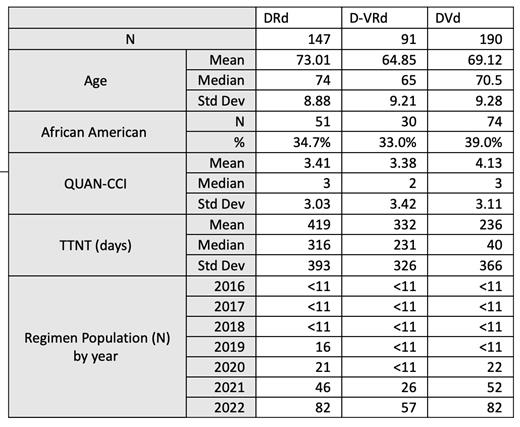Background: Daratumumab is an anti-CD38 antibody with efficacy both in relapsed and newly diagnosed multiple myeloma (NDMM).Clinical trials evaluating daratumumab have demonstrated improved outcomes when combined with lenalidomide (DRd) or bortezomib (DVd) and with dexamethasone, as well as using all four drugs (D-VRd). We evaluated characteristics and outcomes of veterans treated with daratumumab combination in NDMM.
Methods: This retrospective, cross-sectional study analyzed electronic medical record data from the Veterans Affairs (VA) Corporate Data Warehouse (CDW). We identified veterans by evidence of daratumumab administration in prescription records in combination with a second agent within 30 days and who did not receive any anti-myeloma agents prior to 30 days. Age, race, Quan's Charlson Comorbidity Index (CCI), the time to next treatment (TTNT), and overall survival (OS) were assessed. Patient characteristics were compared using ANOVA or chi-square and overall survival was estimated using Kaplan-Meier. Analyses were conducted using SAS 9.x.
Results: There were 428 veterans who received daratumumab containing regimens. Mean age was 69.5 years and 36.2% self-identified as African American. There were 147 patients who received DRd, 190 DVd, and 91 D-VRd. Veterans who received DRd were significantly older than veterans receiving DVd (mean 73.0 vs. 69.1 years) and D-VRd(73.0 vs. 64.9 years, p<0.001). Use of daratumumab combinations has increased yearly since FDA approval (see table). There was no significant difference in use of regimens by race or comorbidity, measured by CCI. TTNT displayed distinct variations among the regimens, with DRd showing the most extended duration at a median of 316 days, followed by D-VRd at 231 days, and DVd at 40 days. These observed differences in TTNT may be attributed to changes in regimen, such as starting lenalidomide after 1-2 cycles of DVd. Median overall survival with DRd at 45 months (95% CI 38-not reached (NR)) and with DVd was 28 months (95% CI 20-39). Median survival in D-VRd was not reached.
Conclusion: Daratumumab combinations are increasingly used to treat multiple myeloma in the VHA. DRd is used more commonly in older veterans and D-VRd in younger veterans. DVd is used more frequently than other combinations and veterans may transition or other treatments.
Disclosures
Yin:Parexel International: Research Funding. Lynch:Parexel International: Research Funding. Madison:Parexal International: Research Funding.


This feature is available to Subscribers Only
Sign In or Create an Account Close Modal